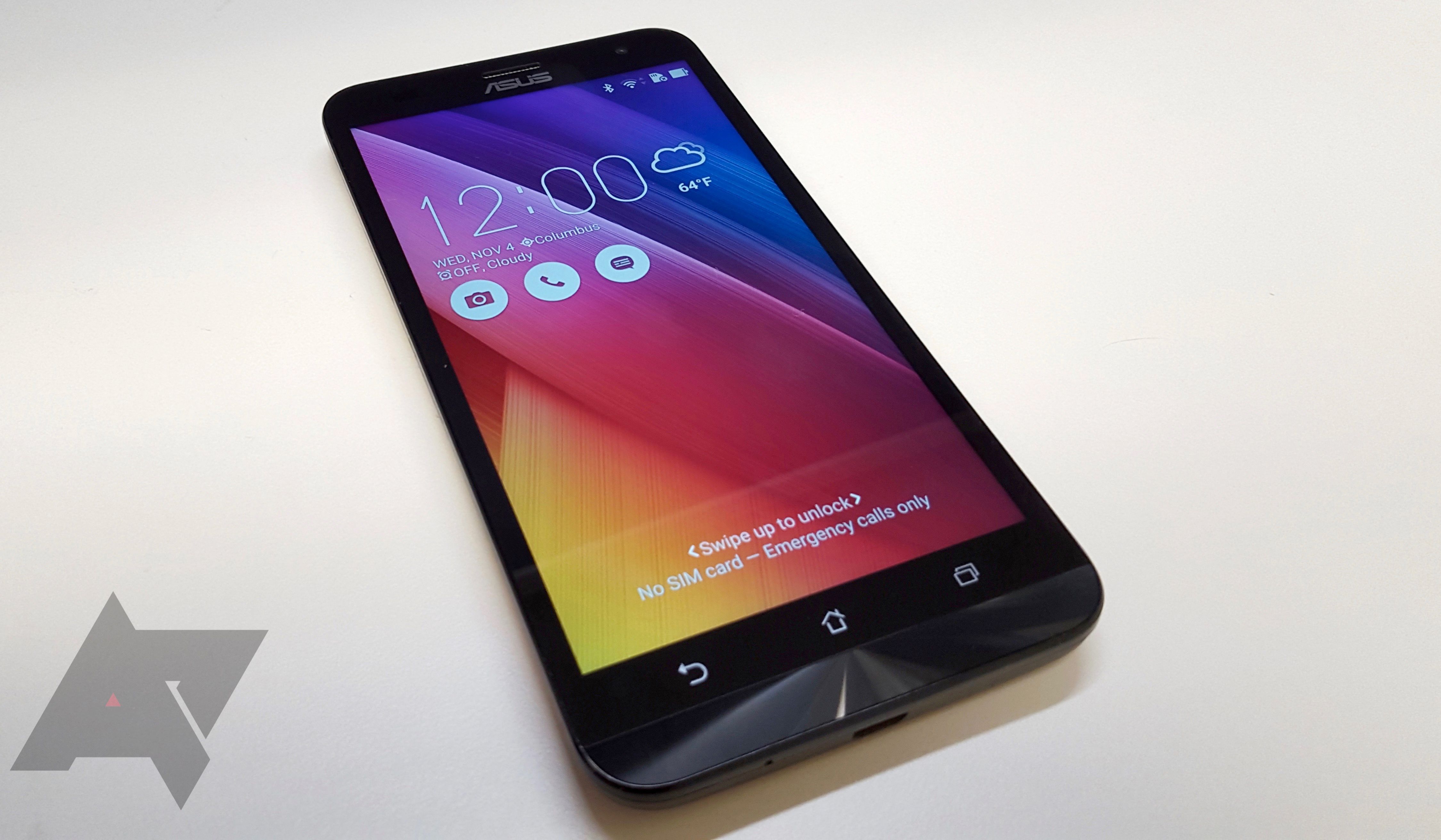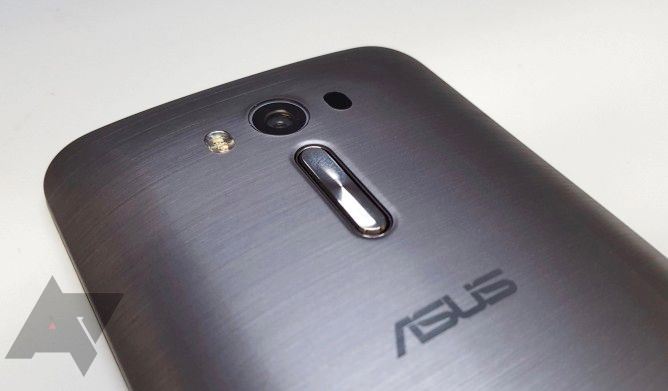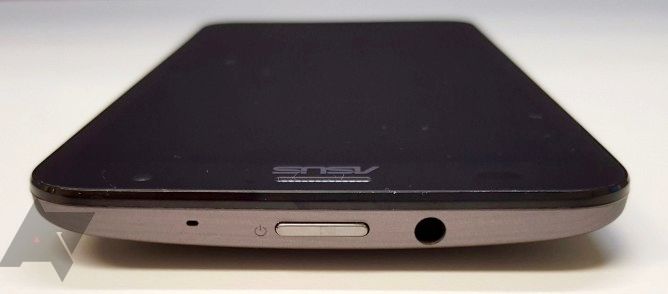Read update
- Clearing up confusion over model differences
Quick Links
ASUS in the recent past has been pushing harder into Western markets and into smartphones in general with the ZenFone product line and its associated ZenUI software layer. Those who remember the Transformer tablets of yesteryear may be surprised at the non-geeky, colorful, feature-filled approach of these devices. Now well into the second generation of ZenFones, ASUS has announced the ZenFone 2 Laser for wide release, including the USA.
It is a slight refinement on the ZenFone 2, which we reviewed back in June. David felt that its base model was one of the best values around for just $199. Well, you can now say the same for the ZenFone 2 Laser, which comes in at $199 for its 16GB model and $249 for the 32GB.
I’ll tease apart the differences in the course of this review, but key differences include the laser focus on the camera, a 64-bit quad octa-core Qualcomm Snapdragon 615 processor (the ZenFone 2 had an Intel SoC), 3GB RAM in the base model (compared to 2GB), and 4G LTE support for both SIM cards. The Snapdragon 615 will be a step down for some purposes, most notably anything graphics intensive. Note also that it is designed for use on GSM networks, like AT&T and T-Mobile in the US.
Here are the full specs:
SPECS
|
Dimensions |
152.5 x 77.2 x 3.9 ~ 10.8 mm (LxWxH) |
|
Weight |
170g with battery |
|
Processor |
Qualcomm Snapdragon 615 MSM8939 |
|
RAM |
3GB LPDDR3 |
|
Storage |
16GB/32GB (each expandable up to 128GB with microSD) |
|
Wi-Fi |
WLAN 802.11 b/g/n |
|
Bluetooth |
4.0, EDR, A2DP |
|
Cellular tech |
2G (GSM)/3G (WCDMA)/4G/LTE on each SIM |
|
LTE Bands |
1/2/3/4/5/7/8/17/20 |
|
Display |
5.5” 1080p IPS |
|
Battery capacity |
3000 mAh Li-Po |
|
Camera |
5MP (front)/13MP (back), laser auto-focus, LED flash |
For a quick run-through of where we’re going, here’s the good and bad in a nutshell.
THE GOOD
|
Laser focus |
It works! Quick, accurate focusing makes taking pictures pretty easy under most conditions. |
|
Battery life |
I wouldn’t expect this much longevity out of a phone with this large of a screen and overall power at this price point. |
|
Software performance |
While the Qualcomm 615 SoC doesn’t have the same graphics prowess that the original ZenFone 2’s Intel SoC had, the typical use is buttery smooth. |
|
Dual SIM |
If you want it, it’s got it. Unlike its predecessor, both SIMs can connect to 3G and 4G LTE (though not simultaneously). |
|
Price |
It’s $199 and that’s just awesome. |
THE NOT SO GOOD
|
Software bloat |
It’s heavily customized, ASUS has a million OEM apps built in, and you get even more third-party stuff pre-installed. |
|
Sex appeal |
For most, this phone won’t be a show-stopper in terms of appearance. While it has the brushed metallic flair common to many ASUS devices, with this color scheme I consider it fairly utilitarian. |
|
Display brightness |
I use my phones outside a lot and it just doesn’t have the punch in those conditions to be very useful. |
|
Size/ergonomics |
This could all be much worse, but the general size of the device could be a turnoff, especially if you have smaller hands than I do. It is also quite thick by today’s standards at 10.8mm. The power button placement centered at the very top is irksome, even if it is partially redeemed by the double-tap to wake feature. |
Design and Build Quality
This phone looks like a handsome ASUS phone. What does that mean? Well, you have ASUS’s familiar brushed metallic plastic case around a fairly straightforward shape and feel. You have two ASUS logos: one on front, one on back. The only color currently offered in the US will be this dark, graphite-like version that is pretty subdued. In terms of appearances alone, I don’t expect this ZenFone to get a lot of attention.
For you, that could be positive or negative. On looks alone, I wouldn’t rule out this phone like I would have some otherwise good devices of the recent past, like the Samsung Galaxy S5 (or S4 before it).
Its design features the same volume rocker placed on the back that its predecessor had, which is a point of uniqueness that I don’t feel strongly about either way. I suppose it is due to an effort to avoid copying LG entirely that the power button is on top, which is an indisputably poor design choice. Not only is the power button on top, it is centered there. It just isn’t easy to reach on a phone with a 5.5” screen.
I was initially ready to tear ASUS a new one before I remembered that they have the double-tap to wake feature, making the power button placement far less important. Overall, while there are bezels that are unimpressive by flagship standards, the phone is easy enough to handle and operate, even one-handed if you are a person with reasonably large hands like me.
A new aspect of the design which is in many ways indistinguishable from the first ZenFone 2 is that the Laser has not just a removable back plate, but removable battery as well. I’m not sure how much of a market there is nowadays for that feature, but all else being equal it’s nice to have.
Display
The US version of the ZenFone 2 Laser has a 1080p, IPS LCD display that is all-around inoffensive. If you are using a recent Samsung device as a daily driver right now, you will notice right away that it’s a step down. Of course, let’s remember that the ZenFone costs $199 brand new. The display is perfectly adequate and more than what I’d expect for this price.
With that said, the aspect of the screen that irked me the most in regular use was its maximum brightness. On a relatively bright day outside, you will have a hard time seeing what you are doing. I had trouble focusing the camera properly when taking pictures for this review solely due to the fact I couldn’t make out what was on the screen. The automatic brightness is also too conservative in my opinion, leaving it too dim for the context; this is a software issue and a matter of opinion, of course, but an overall symptom of the poor backlighting.
Everyday Use
In general, I enjoyed using the ZenFone 2 Laser. I think we all come to these sorts of summary judgments about our devices and for the most part, the overall experience rarely left me frustrated. This says something good about the mixture of hardware and software.
Battery Life
Not unlike what David said in his previous review of the original ZenFone 2, the battery life can be a little bit unpredictable. On the bright side, the baseline longevity is pretty high. I had been using a Galaxy S6 as my personal phone before testing the ZenFone 2 and the ASUS (with its 3000 mAh battery) easily outlasts the Samsung flagship for me.
At times, by the end of the day with around 2 hours of screen-on time and perhaps an hour of screen-off Bluetooth headphone use, it would require charging at bedtime, meaning it could comfortably last upwards of 20 hours even with moderate use. Sometimes, it would easily best that mark, going close to two days with moderate use on a single charge. I cannot tell you what factors affected these changes in battery life.
While I’ll address software a little more directly later, ASUS has included several built-in features and apps meant to address battery life. They vary in their usefulness, but I liked the ability to choose between different energy use profiles along with fairly fine-grained customization if I didn’t like the built-in ones. Even better, you can program the OS to switch into different profiles at different times of day, though I wish it was a little bit more configurable in that regard.
On the other hand, it has an “auto-start manager” that allows you to disable certain apps on boot until you open them up manually. It sounds appealing, but I had some unpredictable behaviors in terms of getting notifications and similar things that I think were a result of this feature.
Camera
One of the main updates from the ZenFone 2 to the ZenFone 2 Laser is the camera. By its description, the sensor appears to be the same, but the added laser focus is no small thing in typical use. Though the software remains imperfect, I think the laser focus helped with some of the inconsistency David dealt with in his review of the original ZenFone 2. To be sure, this thing focuses very quickly and is usually on the money with the first attempt. If you’re debating between the two and wondering if the laser focus adds any value, it does.
Scenes like the one above are really tough on a smartphone camera. I was sitting in the shade in the early afternoon on a cloudy—but still fairly bright—day. I took a few different shots and felt this was the best one without HDR. Below is the best HDR shot I got with it.
In this case, HDR made a big difference and better captured the "real" scene.
I gave this ZenFone the tall task of measuring up to a Samsung Galaxy S6 that I had on hand to take comparison shots. The overall user experience is in some ways quite comparable, with no major difference in focusing speed under most conditions. One area in which the ZenFone 2 Laser really lags behind the S6 is in the HDR speed. While the S6 takes HDR shots so quickly you may not even notice, there was a noticeable pause to allow for all the exposures with the ASUS. This means that you need to be that much steadier and have a target that moves that much less.
Overall, I found basically all the modes other than the auto and pro modes to be more harmful than helpful when it came to getting a good shot, with HDR mode as a possible exception in certain cases.
The laser focus really shows well when taking close-up shots, where it reliably focuses correctly and does it quickly. It even creates a nice depth of field without using its special feature designed to do it with post-processing.
Some comparison shots from a Samsung Galaxy S6 below:
Audio and Speakers
There’s nothing to write home about here in terms of the built-in speaker. It makes noise, it isn’t terrible, but it is very much run of the mill. David complained about headphone output in his review, tentatively attributing it to the Intel SoC in the original ZenFone 2. He appears right because the ZenFone 2 Laser—sporting a Qualcomm SoC—had no such problems with headphone output. Bluetooth audio was surprisingly good as well.
Software
ASUS’s very proprietary ZenUI runs on top of Android 5.0.2, which is fairly out of date at this point but is perfectly adequate given everything else. The UI customization is deep and pervasive, so it is an unmistakably ASUS spin on Android, though I think it is up for debate whether it is really all that bad. I appreciate manufacturers trying to add value and like to approach these things with an open mind.
With that said, holy hell are there a lot of unneeded apps on this phone. Not only does ASUS offer its own alternative to every stock Android and Google service, there is a fair amount of straight up crap preloaded on here. On the bright side, at least the third-party apps can be fully uninstalled. Other potentially undesired apps can be disabled, similar to Samsung’s implementation on recent devices. In fact, you can think of the entire philosophy as similar in spirit to Samsung in that ASUS defaults into making their own version of as many things as possible.
Performance
Generally speaking, the phone operates smoothly and responsively. I keep making Samsung comparisons and one is apt here. It is at least as smooth if not smoother in terms of UI responsiveness than my AT&T Galaxy S6. This is not necessarily a high bar, but the S6 is still the major flagship out there.
While I can go hunting for stutters and lags and find them, the ZenFone 2 Laser is on the whole a smooth operator. Not once in about two weeks of regular use did I have something just fail spectacularly on me; there were no system UI crashes, no oddly long lags, no clunky app switching incidents.
For all the drawbacks of ZenUI, which to me are chiefly in the arbitrary changing around of everything, my sense of it is that in this device they at least haven’t sacrificed performance too much. Do watch out for the aforementioned auto-start manager and a couple of third-party apps that exist mainly to kill running apps and clean out RAM. That just isn’t helpful and you will need to disable/remove these features.
Rating 8.5/10
ASUS ZenFone 2 Laser
If you are on a budget and are not totally averse to OEM customization of Android, you should really give the ZenFone 2 Laser a look. Its strengths are in its value for dollar, the quality of its screen, UI performance, and overall camera experience. More importantly, though, my take is that it lacks a real killer flaw. And when you are shoppping for non-flagships (and flagships, to be honest), there’s almost always that one thing that’s missing and turns you off entirely.
To the extent that the ZenFone 2 Laser has one of those fatal flaws, it would be the software. Between the heavy, sometimes annoying customization and the fact that it's running Android 5.0.2, that doesn't bode well for how quickly updates will roll out in the future. With that said, I would say that if you get along with Samsung's or LG's software, you can deal with ZenUI as well.
If you’re the type to care about this, ASUS devices have typically been relatively friendly to custom ROM development. The original ZenFone 2 has generated plenty of indie developer interest over at XDA Developers.
The camera isn’t quite on the level of the $700+ 2015 flagships, but it should please all but the most exacting buyers. I was pleasantly surprised at both the end products and the ease with which you can take those photos. This is a pretty common trend with the phone. Most aspects don’t blow you away, but you would be justifiably surprised that you can get them for the price.
For $199, I'm not sure you can do better than the ZenFone 2 Laser.
You can buy it now directly from ASUS.
Note: The unit discussed was sent to us by ASUS for the purposes of this review.
UPDATE: 2015/11/05 9:49pm PST BY
Clearing up confusion over model differences
To clear up confusion, the unit in this review is model number ZE551KL. The specs listed previously are accurate for this model only. ASUS has chosen to market several different variations as the ZenFone 2 Laser, including some with 5" and 6" screen sizes some of which have 720p resolution, Snapdragon 410 SoC, and 2GB/4GB RAM configurations. Many of these are only available in particular markets. A forthcoming review will look at the ZenFone Selfie as well as a brief look at a slightly scaled-down ZenFone 2 Laser with 2GB RAM and 720p display.






